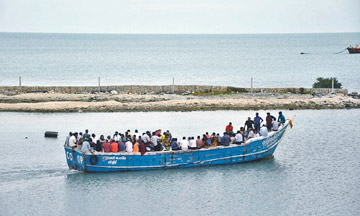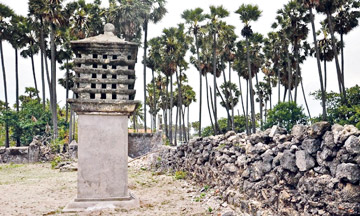Delft Island turns into a major tourist attraction
by Ranil Wijayapala
 |
| Horses and
ponies roaming freely, the main attraction |
 |
| Stables |
 |
| |
 |
| Ancient pigion
cage |
 |
| Garment
factory, the first employment generating venture |
The chirpy waters of the Indian ocean greets us with its spray on our
face as we walked on along the Kurikadduwan jetty towards the water jet
of the Sri Lanka Navy that was awaiting to take us to the remotest
inhabited island belonging to Sri Lanka, Delft or the island of
Neduntheevu as people in Jaffna called it.
After 40 minutes drive from the Jaffna town on the bumpy roads across
Velanai and Punguduthivu causeway we reaced Kurikadduwan jetty or
famously known as KKD jetty among the Naval community. The jetty is
famous among the southern people also as it is frequently used by them
to reach famous Nagadeepa temple in the Nainatheevu island.
Though thousands of people visit Nagadeepa or Nainatheevu islands on
a daily basis, the island of Delft is out of reach for many of them, may
be due to the lesser frequency of the ferry services to the island and
also due to a journey through the rough seas of the Indian ocean
unbearable for ordinary people when the sea is rough.
But the accessibility to the island has been improved recently with
the re-launching of the Vada Tharaki-II passenger vessel from
Kurikadduwan Jetty to Delft Island as a joint project by the Road
Development Authority and the Sri Lanka Navy. The service had been
abandoned due to terrorist activities and re-launched in May this year
to provide free transport facilities for the islanders.
In the absence of the Vada Tharaki II, two other ferry boats are
operated one owned and run by Delft Co-operative society and another by
a private owner.
To take the real feeling of a sea voyage and the true sense of living
in an island far from the mainland one has to visit the island in a
normal ferry boat along with hundreds of people using the boat for their
daily travelling to the main island. Though a speedy water jet takes
only ten to 15 minutes for ten kilometres journey from KKD jetty the
normal ferry boat takes 45 minutes to one hour to reach the destination.
Despite the difficulty in travelling, many tourists both local and
foreign specially the Dutch are keen on visiting the island as the
trails of the colonial influence on the island still exist in the
island. But one can observe how the population in this island live
harmoniously with the Sri Lanka Navy who have become their life time
partner for decades.
Once a habitat only for the people living in the island who mainly
depended on the supplies that came through Sri Lanka Navy are now
enjoying a new lease of life and day by day improving their living
standards in the peaceful environment that prevails in the island.
The green pastures are slowly rising to replace the dried grass and
mossy on the usually scorched earth spread on the layers of lime stones
in the island as the rainy season has just begun there.
The island that was protected by the Sri Lanka Navy during three
decades long armed conflict still experience the harmonious living with
the Sri Lanka Navy as the main supplier to the island.
‘SLN Vasamba’, the Navy base which was confined only to a small
building during the war has now developed in to a storeyed building and
rise majestically facing the pier that links the island with the rest of
the peninsula through sea.
Unrestricted movements are there in the island and civilians now
enjoy the full freedom of their life without waiting to get clearance
for their entry to the island at the entry point to the island a memory
that I had in mind during my first visit to the island in the peak of
the war in 2008. Though it was confined to the people living there
during the war, many people are now visiting the island to enjoy the
life there and to see the historic colonial roots in the island. The
‘Dimo Batta’ lorry waiting close to the pier is one mode of transport
for the visitors to the island which spans nearly eight kilometres
stretch.
If the group is big there is another alternative arrangement to hire
the bus which is run by the Road Development Authority to travel across
the island and to return to the pier to catch the ferry from Delft to
KKD.
The ‘Growing Stone’ which the Hindus believe represents the God
‘Eeshwara’ and worshipped by the devotees at an annual festival
organised by the nearby Kovil is a centre of attraction in the island.
The Delft island represent the harmonious living of human being and
the animals as one part of the island is dedicated for the wild horses
and ponies roaming freely in the island. These wild creatures are living
harmoniously with the people sharing the resources available in the
island.
As the dry season comes, the Navy personnel in the island used to
provide water for the wild horses and also the cows after filling the
tanks created in certain locations of the island. That enables these
wild creatures survive during the dry weather. But many wild horses,
ponies and cows can be found dead during the dry season but with the
start of the rainy season in September lot calves of ponies and wild
horses can be found in the greener pastures.
Both human beings and the animals depend on the fresh water supply at
‘Devil’s Well’ the only fresh water source in the island and Navy
personnel assist both animals and the human being to get their required
drinking water from them.
The giant ‘baobab tree’ with a cave type inside for five to six
people to stand comfortably, the old stables of the Dutch era and the
giant foot prints are places worth visiting in the island.
The ancient Buddhist ruins at one end of the islands and the recent
discovery of two inscriptions by the Maritime Archaeology Unit of the
Central Cultural Fund has increased the archaeological value of the
island.
The roots of the Dutch era is visible clearly in the island with
scattered ruins of Dutch Fort and Court House located in the premises of
the Delft hospital.
The civilians are having humble living after cultivating their barren
lands once a year and producing palmyrah toddy, kottakilangu and other
handicraft from the Palmyra tree as their living. But many of them are
now depending on the money coming from the relatives living abroad.
Though situated far from the Jaffna peninsula no one need to worry
about the power supply as the CEB run generators are providing 24 hour
power supply to more than 4,500 population living in Delft.
To provide power supply for the islanders the Sri Lanka Navy has
embarked on a project to supply electricity for many households in the
island.But many of the fishermen living there in the island are raising
their voice against the Indian fishermen poaching into their territory
as they are losing major fish catch three days of the week.
The garment factory run by the Sri Lanka Navy to produce Navy
uniforms is the only employment generating venture in the island.
Started in August 2011, the factory continues to supply jobs for nearly
50 youth in the delft island. It enables the youth to earn a minimum of
Rs.12,000 monthly salary. The youth who have not even seen a garment
factory in their life have been trained by the Navy after sending them
to a factory in Galle to be employed in the factory.
As more and more tourists are arriving in the island to have the
unique experience of a voyage in the sea and the real experience of
island living, Delft is opening up opportunities for a booming tourist
industry with its scenic beaches.
The cabanas coming up there in certain locations in the island give
positive signals that island will no longer be an isolated one from the
mainland and create more links with the people in near future.
Pix : Thilak Perera
|

